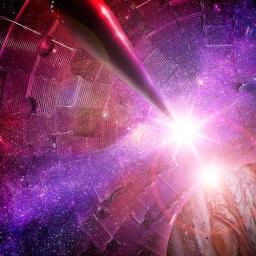
The conditions deep inside large planets, such as Jupiter, Uranus and other planets recently discovered outside our solar system, have been
experimentally recreated. This allows researchers to re-create and accurately measure material properties that control how these planets evolve over time (information that is essential for understanding how these massive objects form).
Using the largest laser in the world, the National Ignition Facility at Lawrence Livermore National Laboratory, teams from the Laboratory, University of California, Berkeley and Princeton University squeezed samples to 50 million times Earth's atmospheric pressure, which is comparable to the pressures at the center of Jupiter and Saturn. Of the 192 lasers at NIF, the team used 176 with exquisitely shaped energy versus time to produce a pressure wave that compressed the material for a short period of time. The sample -- diamond -- is vaporized in less than 10 billionths of a second.
Though diamond is the least compressible material known, the researchers were able to compress it to an unprecedented density greater than lead at ambient conditions.
"The experimental techniques developed here provide a new capability to experimentally reproduce pressure-temperature conditions deep in planetary interiors," said Ray Smith, LLNL physicist and lead author of the paper. Such pressures have been reached before, but only with shock waves that also create high temperatures -- hundreds of thousands of degrees or more -- that are not realistic for planetary interiors. The technical challenge was keeping temperatures low enough to be relevant to planets. The problem is similar to moving a plow slowly enough to push sand forward without building it up in height. This was accomplished by carefully tuning the rate at which the laser intensity changes with time.
"This new ability to explore matter at atomic scale pressures, where extrapolations of earlier shock and static data become unreliable, provides new constraints for dense matter theories and planet evolution models," said Rip Collins, another Lawrence Livermore physicist on the team.
Abstract The conditions deep inside large planets, such as Jupiter, Uranus and other planets recently discovered outside our solar system, have been experimentally recreated. This allows researchers to re-create and accurately measure material properties that control how these planets evolve over time (information that is essential for understanding how these massive objects form).
The conditions deep inside large planets, such as Jupiter, Uranus and other planets recently discovered outside our solar system, have been experimentally recreated. This allows researchers to re-create and accurately measure material properties that control how these planets evolve over time (information that is essential for understanding how these massive objects form).